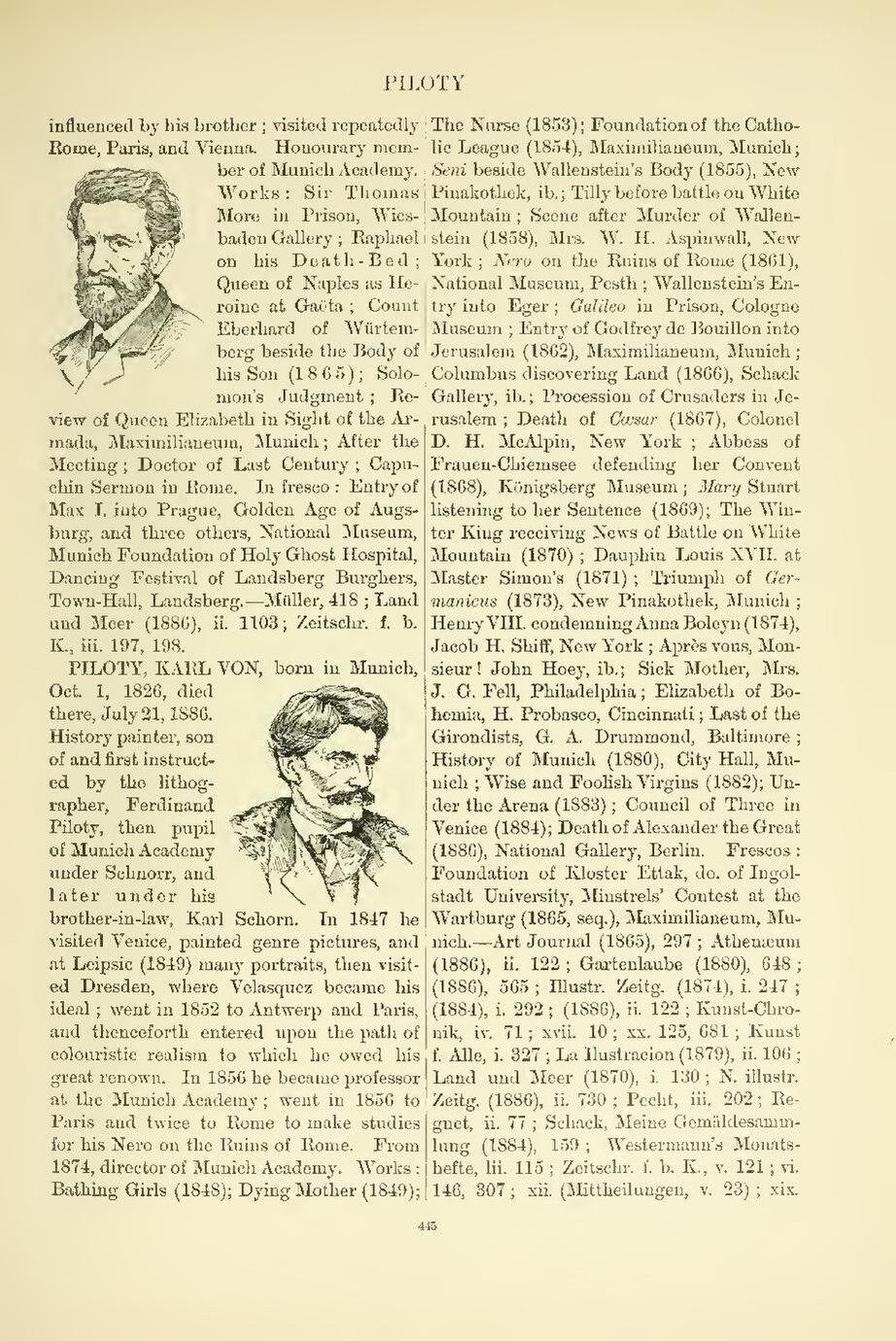influenced by his brother; visited repeatedly Rome, Paris, and Vienna. Honourary member of Munich Academy. Works: Sir Thomas More in Prison, Wiesbaden Gallery; Raphael on his Death-Bed; Queen of Naples as Heroine at Gaëta; Count Eberhard of Würtemberg beside the Body of his Son (1865); Solomon's Judgment; Review of Queen Elizabeth in Sight of the Armada, Maximilianeum, Munich; After the Meeting; Doctor of Last Century; Capuchin Sermon in Rome. In fresco: Entry of Max I. into Prague, Golden Age of Augsburg, and three others, National Museum, Munich Foundation of Holy Ghost Hospital, Dancing Festival of Landsberg Burghers, Town-Hall, Landsberg.—Müller, 418; Land und Meer (1886), ii. 1103; Zeitschr. f. b. K., iii. 197, 198.
An image should appear at this position in the text. To use the entire page scan as a placeholder, edit this page and replace "{{missing image}}" with "{{raw image|Cyclopedia of painters and paintings (IA cyclopediaofpain03cham).pdf/467}}". Otherwise, if you are able to provide the image then please do so. For guidance, see Wikisource:Image guidelines and Help:Adding images. |
An image should appear at this position in the text. To use the entire page scan as a placeholder, edit this page and replace "{{missing image}}" with "{{raw image|Cyclopedia of painters and paintings (IA cyclopediaofpain03cham).pdf/467}}". Otherwise, if you are able to provide the image then please do so. For guidance, see Wikisource:Image guidelines and Help:Adding images. |
PILOTY, KARL VON, born in Munich,
Oct. 1, 1826, died
there, July 21, 1886.
History painter, son
of and first instructed
by the lithographer,
Ferdinand
Piloty, then pupil
of Munich Academy
under Schnorr, and
later under his
brother-in-law, Karl Schorn. In 1847 he
visited Venice, painted genre pictures, and
at Leipsic (1849) many portraits, then visited
Dresden, where Velasquez became his
ideal; went in 1852 to Antwerp and Paris,
and thenceforth entered upon the path of
colouristic realism to which he owed his
great renown. In 1856 he became professor
at the Munich Academy; went in 1856 to
Paris and twice to Rome to make studies
for his Nero on the Ruins of Rome. From
1874, director of Munich Academy. Works:
Bathing Girls (1848); Dying Mother (1849);
The Nurse (1853); Foundation of the Catholic
League (1854), Maximilianeum, Munich;
Seni beside Wallenstein's Body (1855), New
Pinakothek, ib.; Tilly before battle on White
Mountain; Scene after Murder of Wallenstein
(1858), Mrs. W. H. Aspinwall, New
York; Nero on the Ruins of Rome (1861),
National Museum, Pesth; Wallenstein's Entry
into Eger; Galileo in Prison, Cologne
Museum; Entry of Godfrey de Bouillon into
Jerusalem (1862), Maximilianeum, Munich;
Columbus discovering Land (1866), Schack
Gallery, ib.; Procession of Crusaders in Jerusalem;
Death of Cæsar (1867), Colonel
D. H. McAlpin, New York; Abbess of
Frauen-Chiemsee defending her Convent
(1868), Königsberg Museum; Mary Stuart
listening to her Sentence (1869); The Winter
King receiving News of Battle on White
Mountain (1870); Dauphin Louis XVII. at
Master Simon's (1871); Triumph of Germanicus
(1873), New Pinakothek, Munich;
Henry VIII. condemning Anna Boleyn (1874),
Jacob H. Shiff, New York; Après vous, Monsieur!
John Hoey, ib.; Sick Mother, Mrs.
J. G. Fell, Philadelphia; Elizabeth of Bohemia,
H. Probasco, Cincinnati; Last of the
Girondists, G. A. Drummond, Baltimore;
History of Munich (1880), City Hall, Munich;
Wise and Foolish Virgins (1882); Under
the Arena (1883); Council of Three in
Venice (1884); Death of Alexander the Great
(1886), National Gallery, Berlin. Frescos:
Foundation of Kloster Ettak, do. of Ingolstadt
University, Minstrels' Contest at the
Wartburg (1865, seq.), Maximilianeum, Munich.—Art
Journal (1865), 297; Athenæum
(1886), ii. 122; Gartenlaube (1880), 648;
(1886), 565; Illustr. Zeitg. (1874), i. 247;
(1884), i. 292; (1886), ii. 122; Kunst-Chronik,
iv. 71; xvii. 10; xx. 125, 681; Kunst
f. Alle, i. 327; La Ilustracion (1879), ii. 106;
Land und Meer (1870), i. 130; N. illustr.
Zeitg. (1886), ii. 730; Pecht, iii. 202; Regnet,
ii. 77; Schack, Meine Gemäldesammlung
(1884), 159; Westermann's Monatshefte,
lii. 115; Zeitschr. f. b. K., v. 121; vi.
146, 307; xii. (Mittheilungen, v. 23); xix.
